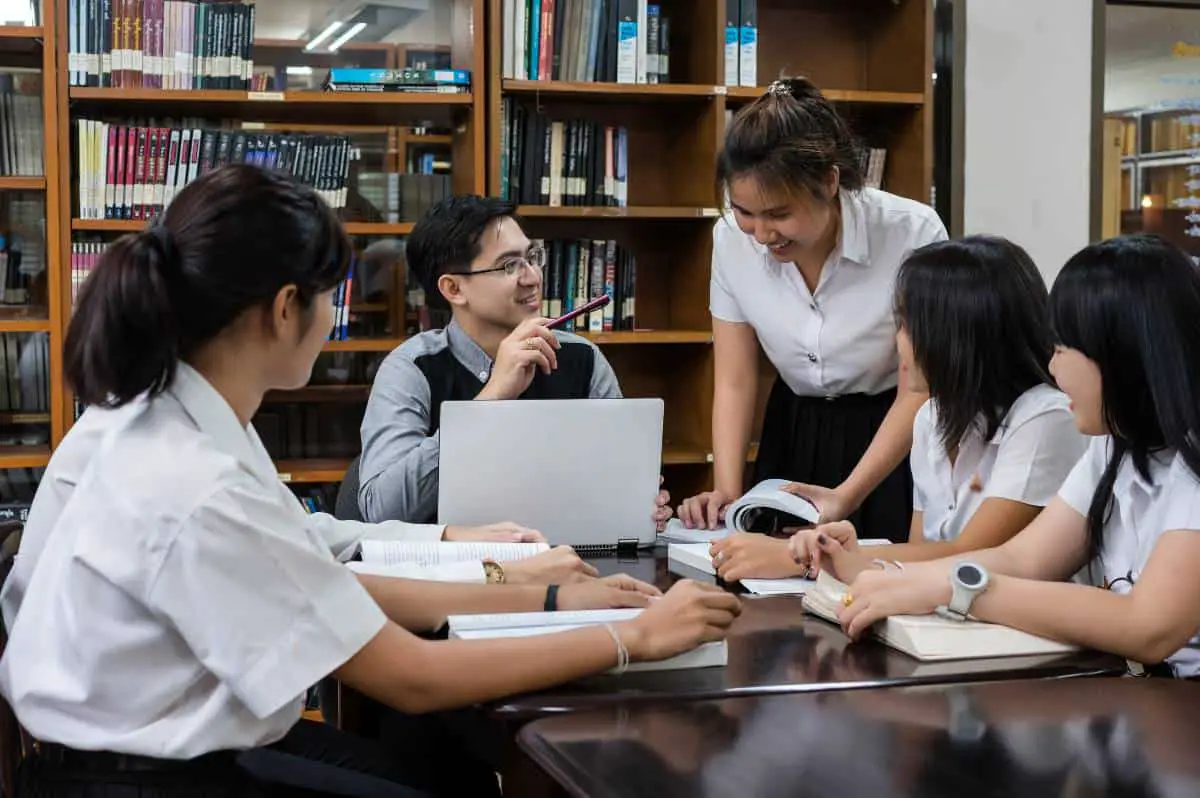How Does Thai Education System in Thailand Work?
Hey there! Tom from BetterLivingAsia.com here. Settling into a new country can be tough for families – my wife and I certainly had adjustments when we first moved our kids to Thailand. One big question is always: what are we going to do about their education?
I know the Thai school system can seem confusing or intimidating from the outside. But after 35 years in the States, then over a decade raising teens and tweens in Thailand, I’ve learned a few things. So let me break down the basic structure first, then dig into the common options available. My goal is that you walk away feeling empowered to make the best decisions for your children’s learning needs and styles.
Key Takeaways
- The Thai Asia education system has both public and private options, with international schools offering curriculums from various countries.
- While public schools are affordable, large class sizes and variable quality can be cons. Private and international schools have higher fees but more resources.
- Recent reforms are working to improve access and standards, but rural schools still face disparities.
Overview: How Thai Schools Are Organized
First, it helps to realize that Thai education includes both public and private establishments. Public schools follow a national curriculum dictated by Thailand’s Ministry of Education. Private schools have more control over what and how they teach. You also have international schools delivering non-Thai curriculums.
In all cases, schooling is:
- Mandatory from age 6
- Free at public schools until grade 9
- Taught primarily in the Thai language
Here’s a quick cheat sheet:
Basic Structure
- Pre-primary: Ages 3-5, optional kindergarten
- Primary: 6 years (Prathom 1-6), ages 6-11
- Lower secondary: 3 years (Mathayom 1-3), ages 12-14
- Upper secondary: 3 more years (Mathayom 4-6), ages 15-17
After grade 12, academic higher education includes vocational colleges and multi-year university degrees.
Public, Private, or International?
The three main options come with very different classroom experiences and price tags:
Public Schools
Around 90% of Thai children attend free public schools. As mentioned earlier, these are funded by the government up until 9th grade. Thai public schools form the backbone of education and communities.
Some key points:
- Curriculum: Follows national standards, focus on Thai, math, and science.
- Language: Taught in Thai, some offer English electives.
- Fees: “Free” but extras like uniforms, and supplies can add up.
- Size: Often large classrooms, 30:1 student-to-teacher ratios.
Pros of public schools include exposure to the Thai language/culture, low tuition costs, and local integration.
Cons can be large classes, variable quality, and limited English instruction options. Facilities depend heavily on the school district funding.
Every public school is government-rated from 1 to 5 stars. More stars equal more resources. For expats though, even 5-star may lack enough English support.
Private Schools
In 2021, close to 2.8 million students were enrolled in private schools in Thailand. These operate more like private academies. Various religious (often Catholic or Buddhist) and specialty schools exist too.
Here are some key private school factors:
- Curriculum: Must cover core topics but be more flexible.
- Language: Varies greatly, some bilingual Thai/English.
- Fees: Average ~$3K USD per year, can offer scholarships.
- Size: Smaller classroom sizes around 25:1.
The pros of private schools include better teacher support, extra-curricular, and smaller classes. The cons can include high costs and still language/cultural gaps for non-Thai families.
But many offer a middle road with English electives or full programs. Examples are Sarasas schools or the specialty Ecole Hôtelière Laksasubsin. These can combine Thai basics with more Western-style academics.
International Schools
Finally, you have the international school path, catering to global families. About 2% of students in Thailand are enrolled across 160+ such schools. Most are centered in Bangkok.
International schools feature:
- Curriculum: Imported from UK, USA, IB, or other
- Language: English instruction throughout
- Fees: Up to USD 25K per year
- Size: Optimized student: teacher ratios
The biggest pros are maintaining a “Western” inspired education in English while allowing students to integrate culturally. International Baccalaureate (IB) schools encourage critical thinking and creativity.
The cons are often high tuition fees, though some schools offer need or merit-based discounts. Spots also fill up fast.
The top international picks for grades, facilities, and value are schools like NIST and the Bangkok Patana School.

Homeschooling
A less conventional but rising option is homeschooling. Around 15,000 Thai families now teach their kids outside school through a legal loophole for “informal education”. Support groups exist, especially in Bangkok, for communal events.
Reasons parents choose to homeschool include:
- Flexible pacing tailored to learning needs
- Nurturing focused education philosophy
- Maximized family time
Homeschool kids often thrive academically and socially. Support organizations like H3 Thailand offer resources plus sports, drama, and field trips that prevent isolation.
Regulations require annual testing through 3rd grade. Homeschooling beyond primary years takes more planning but is equally rewarding. Consider homeschooling groups if exploring this path!
Exploring Different Levels of Education in Thailand
Primary Education in Thailand
Primary education in Thailand spans 6 years, from 1st through 6th grade. This stage lays a foundation across core subjects like Thai language, mathematics, science, and social studies.
Some key aspects of Thai primary schooling:
- Starts at age 6 when compulsory schooling kicks in
- Public options are free but spaces are limited
- Private schools commonly offer small classes
- Can study additional English but costs extra fees
- Students wear uniforms and learn social discipline
Extracurricular activities, even at this young age, are encouraged from sports teams to dance troupes. Field trips connect lessons to real-world learning.
Secondary Education in Thai Schools
Secondary education comes next from 7th through 12th grade, divided into lower and upper sections. Here students dig deeper into specialized academics like physics, literature analysis, algebra, and more.
In lower secondary:
- Students choose elective focus areas
- Many schools track high/low academic streams
- Creative arts and vocational programs expand
- Students prepare for key grade 9 exams
In upper secondary:
- Starts branching towards higher education
- Students prepare for university exams
- Can pick vocational coursework
- Opens access to scholarships and exchanges
Top schools have state-of-the-art labs, technology access, and passionate teachers nurturing curiosity. But quality still varies.
Vocational Education and Training in Thailand
Beyond academic high schools, Thailand embraces technical career education. Agriculture institutes teaching animal husbandry or tourism academies training hotel managers fill crucial economic roles.
Vocational schools provide:
- Alternative to scholarly university path
- Often have competitive admissions too
- Focus on employable trade skills
- Strong job placement outcomes
- May feature apprenticeships, internships
Thailand is expanding vocational investment with 120 new schools in sustainable development, logistics, and other priority workforce domains planned by 2027.
Quality Assessment and International Education in Thailand
National Educational Testing in Thailand
Standardized testing plays a pivotal role in Thai education to benchmark student and school performance. Key national exams include:
- O-NETs: Ordinary National Educational Tests given in grades 6, 9, and 12 assess core competencies in Thai, English, math, science, and social studies.
- V-NET: The Vocational National Educational Test evaluates trades mastery.
- GET: The General Educational Testing exam is used for university admissions placements.
Results make or break academic trajectories, though some criticize an over-focus on rote memorization versus critical thinking. Still, tests are evolving to better evaluate real-world skill applications.
International Schools in Thailand
Over 160 international schools across Thailand deliver elite education adhering to Western curriculums and quality standards.
- Accredited by entities like WASC or CIS
- Features modern pedagogy and experiential learning
- Offers globally recognized qualifications like IB diploma, A-Levels, SAT prep
- Attracts highly qualified teachers
With instruction entirely in English, international schools enable expat students to study seamlessly between countries.
Focus on Quality Education in Thai Institutions
Ensuring excellent and equitable scholastic opportunities for all Thai children motivates ongoing reforms like:
- Raising standards for teacher certifications
- Modernizing material/technological resources
- Customizing curriculums based on community needs
- Expanding access through transportation infrastructure
- Launching satellite campuses in remote areas
Rural schools still suffer disparities but dedicated efforts to spread quality education continue incrementally.
Ongoing Reforms and Disparities
Now you know the basic landscape – from big public schools to niche homeschool pods. But education issues still needing work in Thailand include:
- Access Gaps: Rural area schools are severely underfunded.
- Test Scores: Thai students trail global averages in key subjects.
- Quality Inequality: Teacher support, and technology access vary greatly.
However, you’ll be glad to know the government and non-profits are actively improving education across Thailand continuously.

What Reforms Are Happening?
In the last decade, Thailand’s Ministry of Education implemented a big “20-Year National Strategy Plan” with a focus on learning quality and modernization.
Key goals include:
- Updating outdated curriculums
- Investing more in vocational/STEM programs
- Streamlining bureaucracy
- Improving access to technology
These big-picture plans trickle down to schools getting:
- New computers and the internet
- Renovated buildings
- Expanded pre-K and English classes
The progress made is encouraging, even if some rural access gaps remain, especially with COVID shutdowns rolling things back.
What About COVID-19 impact?
The pandemic sadly hit Thai education hard with 2020 shutdowns forcing remote learning. Just 60% of rural families had internet access for online school.
But communities worked hard supporting families, distributing printed lessons door-to-door in villages. Schools also implemented radio and TV-based learning to reach disconnected kids.
Now in 2024, Thailand balances COVID recovery, both academically and economically, with its long-term educational improvement roadmap. Expect continued innovations in the coming years!
How International Student Programs Bridge Gaps
As globalization marches on, Thailand embraces more overseas students and faculty. This brings welcome diversity and funding to colleges.
For one, dozens of Thai universities now offer full English undergraduate degrees spanning science, tech, and business.
Top picks are Mahidol University’s international business program or Thammasat University’s computer science degrees taught in English.
Many Thai graduate programs are also run in English, like Chulalongkorn University’s Master’s in Economics or master’s of Public Health degrees.
Overseas students find Thai grad schools an affordable option with unique Southeast Asian opportunities for research and field experience.
Scholarships sweeten the deal too – Chiang Mai University provides need and merit-based funding including:
- Living stipends
- Full tuition coverage
- Thai language study
- Healthcare perks
So don’t overlook Thailand as a destination for higher learning!
Choosing Where To Live and Thrive
Navigating schools as an expat family also means picking the right neighborhood or town.
Bangkok offers the most schooling choices, especially international options. But it comes with big city hassles like traffic, pollution and higher costs.
Secondary cities like Chiang Mai have vibrant expat communities too. You sacrifice some amenities but costs drop while livability rises.
If seeking a true island lifestyle, beach towns like Hua Hin or Phuket have solid bilingual schools. These cater to global families embracing coastal living long-term in paradise!
Wherever you settle, remember daily quality of life matters too. Look for family-friendly conveniences like:
- Easy commutes to school
- Public transportation
- Great healthcare facilities nearby
- Parks and recreation
- Weekend getaway potential
FAQs
What are the main options for schooling as an expat child in Thailand?
The three primary options are local public schools, private academies that mix Thai/English instruction, or dedicated “international” schools following Western curriculums.
What is the difference in curriculum and instruction quality across different schools?
Quality, facilities, and teaching standards can vary greatly. Top international schools offer exceptional academics and learning support rivaling elite global institutions. Read school inspection reports carefully regarding instruction quality.
What extra support is available for non-Thai speakers?
Many international and bilingual private schools offer English language learning (ELL/ESL) and academic tutoring. Individual Education Plans (IEPs) are also used to aid those struggling.
How do Thai universities compare internationally?
A handful like Chulalongkorn are globally ranked for research and academics. Others go overlooked but still offer reputable degrees, often at bargain tuition rates for international students compared to schools in the West.
What reforms are happening in Thai education?
Major national strategy plans are continuously invested in upgrading curriculum, training, infrastructure, and access. This includes modernizing classrooms with technology while bridging lingering rural/urban disparities.
How is the Thai language integrated into the education system?
The Thai language is a core subject in the curriculum at all levels of education in Thailand, emphasizing the importance of language proficiency for communication and academic success.
What are the key features of the form of education followed in Thailand?
The form of education in Thailand emphasizes a balance between theoretical knowledge and practical skills development, ensuring students are well-rounded and prepared for the workforce or further studies.
Conclusion
I hope mapping out Thailand’s school landscape helps visualize your family’s options. While the process takes some upfront research, know that amazing Thailand education experiences await in the Land of Smiles.
If public schools work for you, fantastic! But don’t self-limit and rule out private academies, international schools or even homeschooling collectives.
Take time touring facilities and meeting administrators to gauge fit. There’s no one-size-fits-all. Leverage open house events and trial periods that many offer.
Most importantly, collaborate as a family unit on priorities and make group decisions. Stay flexible – you can always change approaches year to year as children grow. Homeschool preschool then switch to a primary academy. Options evolve!
For one-on-one coaching, BetterLivingAsia.com offers family expat planning sessions. We help match your kids’ needs to school offerings across Thailand tailored specifically for you.
Reach out with any other questions in the meantime – I’m always glad to help families blossom in this amazing country. Until next time, be well, and keep smiling!





